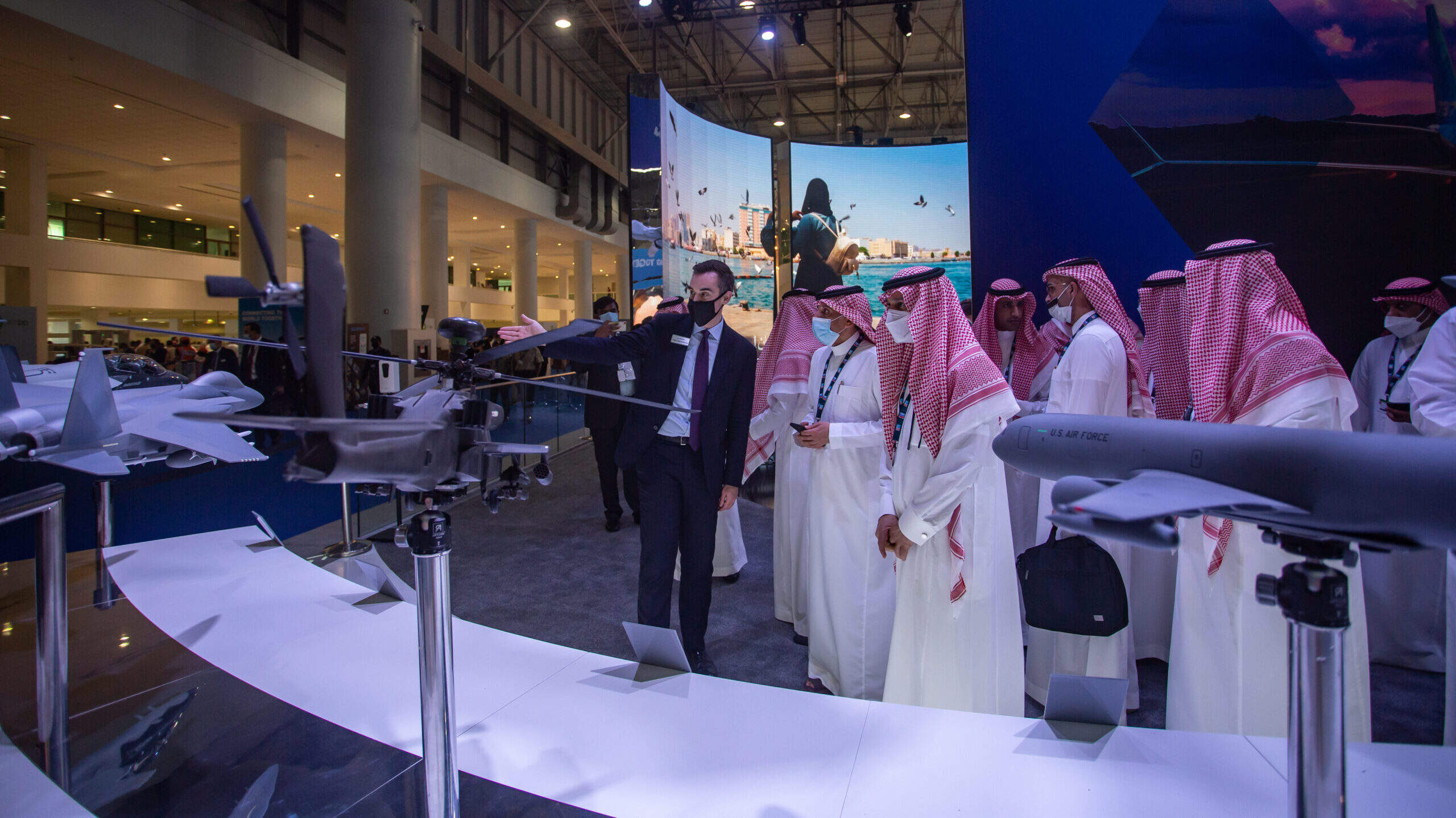
Boeing shows off model displays of their military equipment to a delegation from Saudi Arabia at the Dubai Airshow 2021 on November 14, 2021 in Dubai, United Arab Emirates. (Photo by Andrea DiCenzo/Getty Images)
BEIRUT — The war in Ukraine may have pushed Europe to contribute to the largest global defense spending year in history in 2022, but it was the nations of the Middle East that shouldered the highest average “military burden” per country last year, driven by large jumps in spending from Saudi Arabia and Qatar, according to recent analysis.
According to a report published by the Stockholm International Peace Research Institute, the countries of the Middle East on average spent 3.9 percent of their GDP on defense, what’s known as “military burden,” compared to a global average of 2.2 percent.
But that doesn’t mean every nation increased its overall spending. In fact, while Saudi Arabia and Qatar saw significant increases, most other nations in the region saw their overall military spending stagnate or slightly decline, the report says. That latter group includes, perhaps surprisingly, the military industrial powerhouse that is Israel.
“The regional rise in 2022 was largely due to a 16 percent growth in military spending by Saudi Arabia, the largest spender in the region and the fifth in the world,” SIPRI senior researcher Diego Lopes da Silva told Breaking Defense. “Qatari military expenditure spurted with a 27 percent growth in 2022 to reach $15.4 billion. This is by far the steepest growth rate in the Middle East.”
He added that the increase in the Saudi defense spending is most likely related to a rise in oil prices, but because there isn’t much transparency in the budget, it’s difficult to know for certain how the money was spent.
“Nevertheless, military spending could rise even if a country, in this case Saudi Arabia, is shifting to local production. A country can use its military spending to create a baseline demand for its own arms industry that can protect it from variations in external demand,” da Silva said. Breaking Defense has reported extensively on the Saudi push toward local production, a trend for several countries in the region.
Middle East analyst and senior lecturer at King’s College London Andreas Krieg told Breaking Defense Saudi Arabia is “always undergoing military transformation process” and is “trying to catch up [with the UAE] in terms of modernizing what is a fairly antiquated military.”
While SIRPI and experts acknowledge the report is based on incomplete data, it offers some broad insights into spending trends in the region. For instance, the report notes that Israel’s defense spending, at $23.4 billion, fell for the first time since 2009, even if the nation’s long-term trend line is only going up, an aberration SIPRI attributes to Jerusalem attempting to broadly reduce its budget deficit. Turkey’s defense spending also took a dip, for what the report said is the third year in a row, likely in part due to “soaring inflation.” Iran, it says, spent some $6.8 billion on defense from 2021 to 2022, a 4.6 percent increase over the year before. The report doesn’t include figures for the United Arab Emirates, a notable omission considering that small Gulf nation’s aggressive push into the global defense industry. Da Silva said “unfortunately” SIRPI hasn’t had data from UAE since 2014.
Holes In The Data
In fact, as the report acknowledges gaps in the data, other experts said many figures coming out of the Middle East should be taken with a grain of salt, as they are based in part on self-reported budgets.
“We need to look at Gulf defense spending as [a projection] based rather than being a budget in the Western sense of the word,” Krieg said. “Spending in the Gulf countries are spending on projects as they arise. That’s why you have a lot of variety, for instance it might happen that certain spending being announced in the year for a certain project rather than spreading the budget across many years as is the case in the United States and the UK.”
Both experts Krieg and David Des Roches, associate professor at the Near East South Asia Center for Security Studies, agreed that Gulf states have to procure systems to be self-reliant in bearing the burden of regional security.
Krieg said that these nations don’t have a multilateral approach to defense and security, which means every country must procure its defense systems for itself.
As for the Iranian figures, much of Tehran’s defense spending is also likely more shrouded.
“Iranian defense infrastructure is notoriously opaque, particularly regarding the expenditures of the Revolutionary Guard who have a by some estimates, they can control as much as 30 percent of the Iranian economy, so they’re able to self-fund,” Des Roches commented.
He added that analyzing only spending might be a false measure of capacity, and that small percentage changes might not mean as much as they seem.
“These sort of differences are well within the margin of error of any kind of estimation of overall defense capacity. And honestly, I wouldn’t read too much into it,” Des Roches concluded.
Still, da Silva said based on the data available, it’s notable that while the war in Ukraine has affected the defense budgets in Europe, it seems not to have a large impact on Middle East countries that are facing their own local concerns regarding armed conflicts in Yemen, Syria and asymmetric threat all over the Gulf and Iraq.
“We couldn’t really see a clear connection between the war in Ukraine and military spending in the Middle East. Regional dynamics and conflicts are still the main driver of military spending in the region,” Da Silva said.








